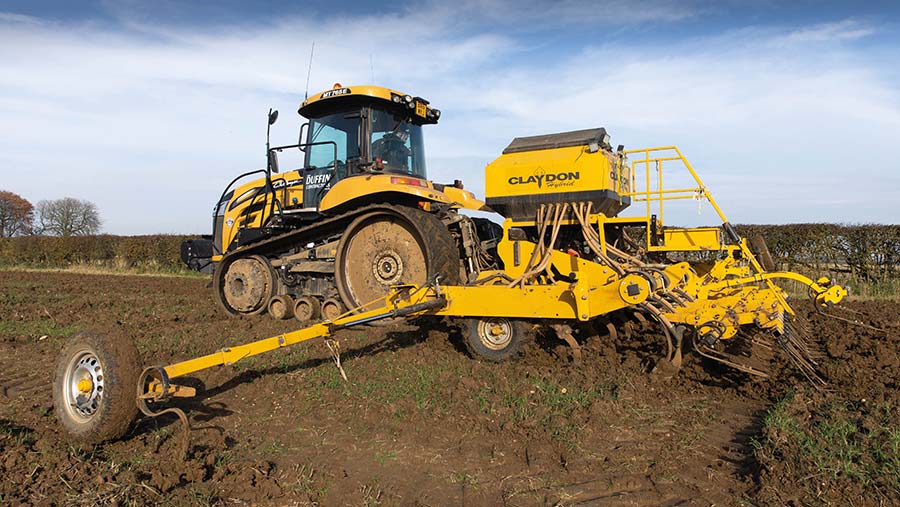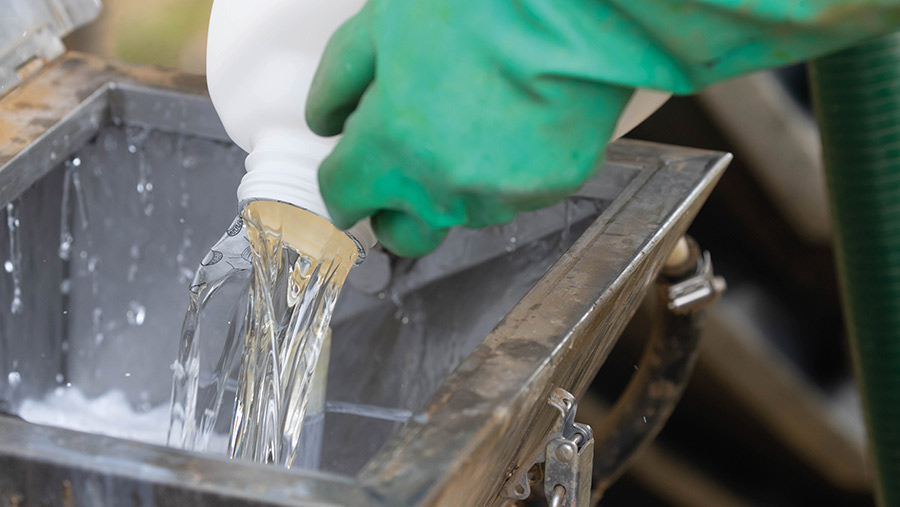Crop Watch: Herbicide shortages and winter bean drilling
 © Tim Scrivener
© Tim Scrivener The recent rain has been welcome, especially in the dry North, where concerns had been growing about the efficacy of residual herbicides for early-drilled cereals.
A shortage of glyphosate was also affecting weed control plans, with co formulation of glyphosate and 2,4D being used to plug some of this gap.
Thoughts are now turning to winter bean drilling and tight supplies of propyzamide are forcing tweaks to herbicide strategies.
North: Mary Munro
AICC/Strutt and Parker (Perthshire)
After one of the easiest harvests in recent times, I worried that autumn sowing would be plagued by endless rain. So far, this has not been the case and the rain we have had was very welcome.
It is not normal to see clouds of dust coming off potato harvesters, but things were getting very dry.
See also: The Soil Health Scorecard: What it is and how to use it
Autumn crops got off to a great start and oilseed rape, in particular, has benefitted from early drilling into warm soils. Most crops are at the six- to seven-leaf stage.
The next task will be spraying with Kerb (propyzamide) once temperatures drop a bit more, and I will be looking to do this in the next 10 days.
Most cereals have had their residual herbicides. Some of these will have been applied in very dry conditions, which can reduce efficacy, so growers will need to bear in mind that follow-ups for grassweeds may be necessary. This should not be a problem for wheat going in now, as there is plenty of surface moisture.
Oat volunteers
The most forward wheats are tillering. I will be planning to take out oat volunteers at the next opportunity.
The timing of agrochemical applications is a small concern compared with the wider issues of fertiliser prices and access, product availability (such as Kerb and glyphosate) and all the problems associated with transport. It is a long time since we have seen pressure on supply to this extent, and growers must adjust to this scenario and do what they can to secure their inputs.
Bearing in mind the concurrent rise in grain prices, the break-even rates of nitrogen have not changed hugely – in many cases a downward adjustment of 10-15kg N/ha is all the fine-tuning that is needed. There is little sense in cutting back to the point where yield is significantly reduced, especially while there are strong prices for grains.
In my view there is no prospect of a big drop in price any time soon. It feels as though Brexit is beginning to make its mark.
West: Stephen Harrison
AICC/Southwest Agronomy (Avon)
After a run of very difficult drilling seasons, it has been a pleasure to see crops established into ideal conditions. Seed-beds are consistently good, save for a few ploughed on heavy soil that dried out.
Emergence here is variable and a little herbicide damage is evident. Maize harvest is almost complete and the first crops for crimping have been cut at a very acceptable moisture content of 36%.
We seem to have caught up with eastern counties as far as herbicide-resistant blackgrass is concerned. If I am perfectly honest, seed-beds are a little on the dry side and the rain this week is welcome for herbicide activity.
Late seed deliveries have been a recurring problem, causing frustration. Thousand grain weights have often been low, with some tinkering of seed rates required. To be fair, the smaller seed does seem to be establishing satisfactorily.
No untreated farm-saved seed has been used, as every sample tested had very high michodochium levels.
Aphids
The first colonies of wingless aphids (mainly bird-cherry oat aphid) have been seen. September-emerging winter barley will receive an insecticide imminently. Continuing mild weather will only aggravate the problem. Don’t forget to restart the T170 countdown as soon as crops have been treated.
Approaching T170 should be a trigger to start looking not spraying. Irresponsible pyrethroid use will simply hasten resistance and damage beneficials.
Oilseed rape crops drilled in early to mid-August are developing large canopies, even after plant growth regulators. Phoma lesions are appearing and will accelerate in the rain.
Please use the in-crop nitrogen next spring – optimising nitrogen inputs assumes an even greater significance this season. We used to talk about wheat and nitrogen price parity; this is out of the window and even oilseed rape can’t match it.
Winter beans are now being drilled. The predominantly farm-saved seed is of good quality with high thousand seed weights, more than 90% germination and minimal seed-borne disease.
The trend towards drilling rather than ploughing down continues.
East: Becky Finbow
Agrovista (Norfolk/Suffolk)
Finally, it looks like we are having a little more of a “normal” autumn, with some of the best seed-beds we have seen for years.
The saying “don’t drill unless you can spray” has been repeated by myself and farmers alike, illustrating just how important the application of pre-emergence herbicide is for the control of blackgrass and ryegrass in winter cereals.
Less-than-ideal autumn conditions over the past couple of years prevented many pre-emergence sprays from being applied, forcing reliance on contact chemistry.
Unfortunately, these herbicides – predominantly sulphonyl ureas – are becoming less effective with the continuous rise in resistant populations of both ryegrass and blackgrass.
Yellow sticky traps were placed into the fields of early-drilled wheats to accompany the use of T-sum to calculate the first barley yellow dwarf virus spray. In Norfolk, esfenvalerate or lambda products are now being applied at the two-leaf stage to suppress aphid populations.
However, where farmers have drilled Wolverine – the first UK variety that is resistant to barley yellow dwarf virus – no insecticide spray is being recommended, as yield is said not to be affected, even in the highest-pressure situations.
Slug threat
The successful OSR harvest has left behind trash which, alongside the wet and warm conditions, has contributed to large populations of slugs this autumn. Traditionally, cereals after OSR have been the main concern, but on heavier land this year I am also finding slug damage on germinating second wheats.
Ferric phosphate has been applied shortly after drilling on crops after OSR, but I continue to keep an eye out as a further application may still be needed.
With wheat drilling well under way, farmers are starting to think about their winter bean crops. Home-saved seed should be tested for both nematodes, ascochyta and germination to ensure quality before drilling.
Beans provide an excellent opportunity to get on top of grass- and broad-leaved weeds, with the later drilling window allowing for a stale seed-bed and a good variety of pre-emergence herbicide choices.
In Suffolk, where blackgrass is the primary concern, propyzamide will be the backbone of my pre-emergence programme, with the addition of pendimethalin plus or minus clomazone for broad-leaved weeds.

© Tim Scrivener
South: Richard Harding
ProCam (Sussex)
The very unsettled weather in the past week on the Downs has been widespread, with very little fieldwork being done until the middle of last week on heavier soil types on the Weald.
Rainfall has varied from anywhere between 40-50mm to 78mm falling in three days. This rainfall has delayed both drilling and spraying of pre-emergence herbicides, but every day of delay is also reducing the blackgrass pressure.
As drilling gets later, the pre-emergence stack used to date – Avadex (tri-allate), fluefenacet, diflufenican and prosulfacarb + glyphosate – will now be simplified, where possible, leaving the easier-to-control broad-leaved weeds such as mayweed, groundsel or volunteer beans to the spring.
Earlier-drilled cereals that are at one to two leaves or larger are being checked for aphids. Yellow sticky traps are also useful to help with monitoring aphid levels, used in combination with the 170-day degree threshold for these crops (https://ahdb.org.uk/bydv) and based on crop emergence date.
Glyphosate shortage
With glyphosate in very short supply this autumn, as well as being less active on broad-leaved weeds and OSR volunteers, a co-formulation of glyphosate and 2,4D is helping to plug the gap and protect any straight glyphosate that may be left in stock.
However, in some situations, such as volunteer beans, it may well be cheaper and more effective to control this weed in the following cereal crop.
Winter oilseed rape crops vary greatly from just reaching the three- to four-true-leave stage to well over 30cm tall in companion crops that now have a white/purple hue from the phacelia, buckwheat and linseed.
Cabbage stem flea beetle levels are generally low, although larvae are just starting to be found in plants, albeit at very low levels.
With the first winter bean crops being drilled and a shortage of propyzamide this season, higher rates of prosulfocarb and pendimethalin will be used for the pre-emergence herbicide, adding clomazone where cleavers are a high risk.

